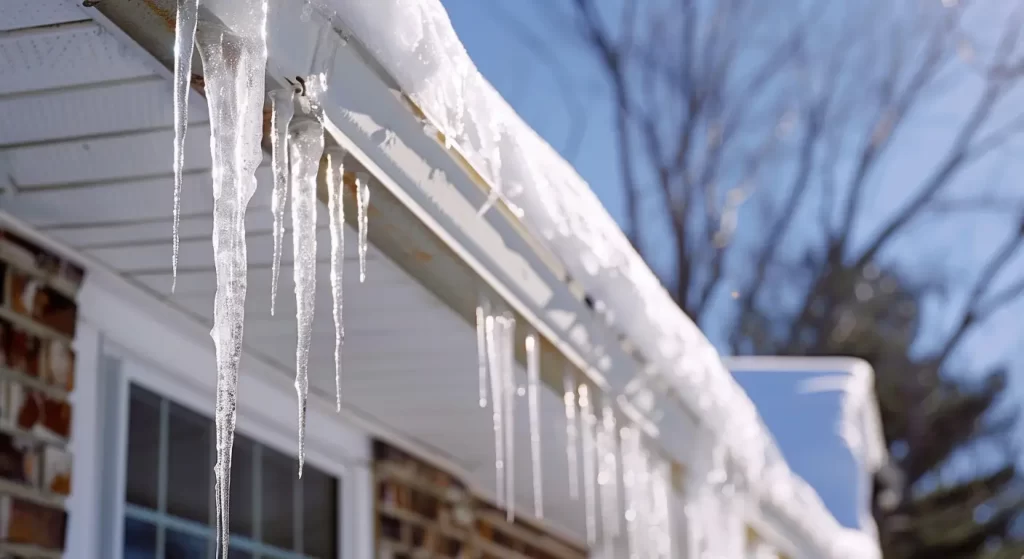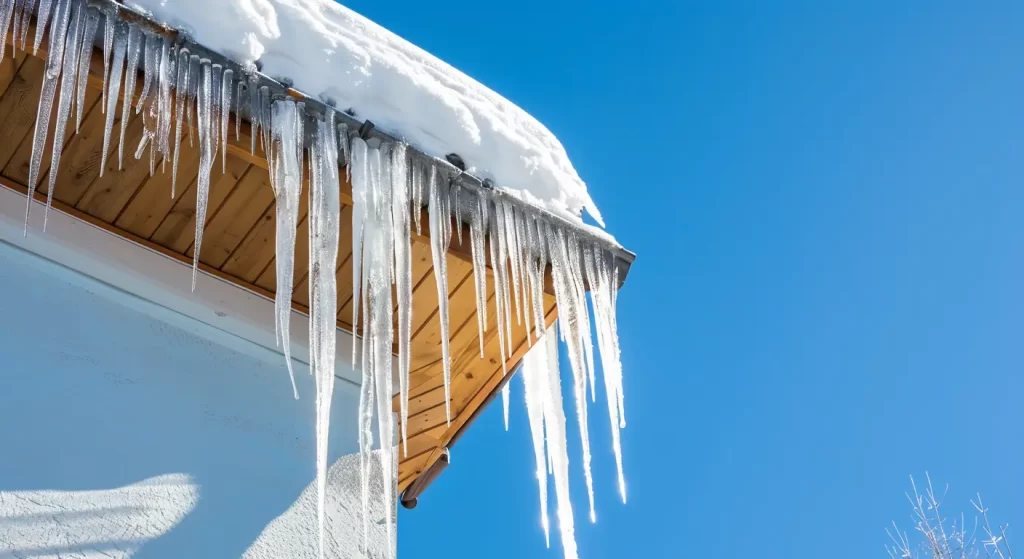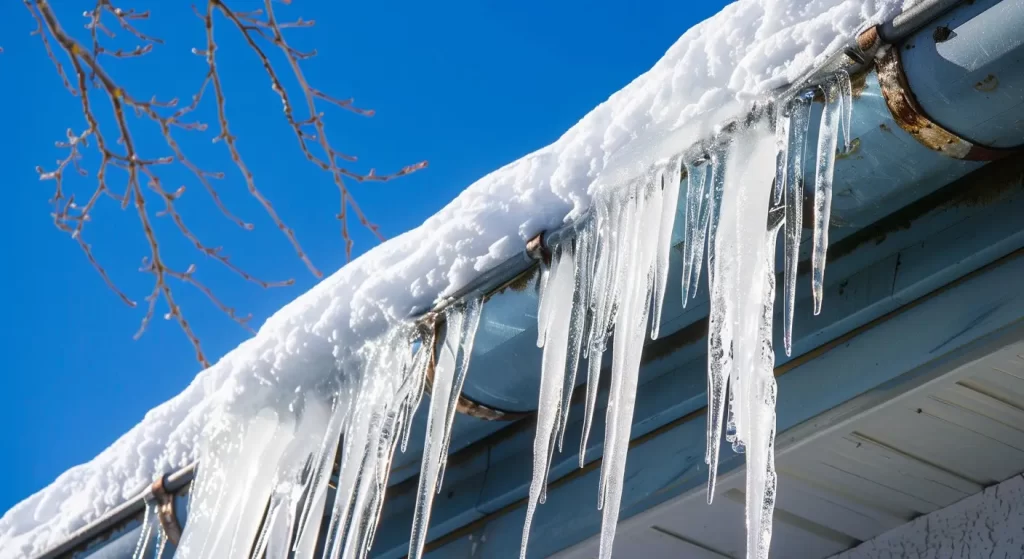Ice dams, while common in colder conditions, can wreak havoc on your roof and home, particularly when snow melts and refreezes at the roof’s edges. Left unchecked, they cause water damage, leaks, and even mold growth, putting your property at risk. With over 25 years of experience, Shield Roofing, San Antonio’s trusted roofing contractor, provides proven solutions to manage these concerns. By focusing on essential steps like proper attic insulation and professional removal, you can prevent lasting issues from compromising your home’s integrity.
Ice Dams Explained
An ice dam forms at roof edges when melting snow on warmer sections refreezes at colder eaves, trapping water that can seep under shingles and damage your home.
Ice dams are mainly caused by heat loss from poor attic insulation or uneven roof temperatures. As the underside of the roof warms, snow melts unevenly, flowing down and refreezing in cooler areas. This often occurs in regions with fluctuating temperatures, like San Antonio, which may face ice dam issues during specific weather patterns. Understanding this process is essential for protecting your home.
Causes of Ice Dams
Ice dams can surprise San Antonio homeowners, resulting from heat loss and fluctuating roof temperatures. Warm air escaping to the attic melts snow on the roof, even in cold weather, due to inadequate insulation.
This uneven melting happens when attic insulation fails to maintain temperature. Melted snow flows down and refreezes at the eaves, forming dams, while poor ventilation exacerbates the problem.
Though rare in southern regions, ice dams can threaten homes during severe winter storms. Proper insulation is vital for protecting your roofing system against unusual weather patterns. Let’s explore how to identify potential dam risks for your home.

Typical Signs of Ice Dam Formation
Early signs of those dams are crucial to detect before they cause damage. Watch for:
- Displaced or damaged shingles.
- Water stains or leaks on ceilings and walls.
- Bulging areas near eaves, indicating trapped moisture.
- Overflowing or clogged gutters during freeze-thaw cycles.
Additionally, any sagging ceilings or mold growth warrant immediate inspection. If left unchecked, these issues can lead to costly repairs. Stay vigilant, especially after heavy snowfall in San Antonio. Shield Roofing professionals can evaluate and address these concerns to protect your home.
Preventing Ice Dams on Your Roof
Taking proactive measures can stop ice dams from compromising your roof. A two-step approach focuses on improving insulation and ensuring adequate ventilation in your attic. By maintaining a consistent roof temperature, you reduce the risk of ice accumulation on roof edges.
Additionally, removing snow buildup promptly using a roof rake or similar tools is an effective deterrent. Diligence in these areas not only protects your home but prevents unnecessary expenses stemming from the damage caused by an ice dam. Let’s look at the best practices in detail.

Insulation and Ventilation Best Practices
Effective insulation and proper ventilation are vital in preventing ice dams. Correctly installed attic insulation minimizes heat loss, keeping the roof cool in colder climates. Use high-quality materials to prevent warm air from escaping into the attic, which can cause snow to melt and refreeze along colder eaves.
Adequate ventilation through continuous soffit and roof vents circulates attic air, maintaining a balanced temperature. These practices not only reduce ice dam damage but also combat mold and mildew, preserving your roof’s integrity and your home’s health.
Professional Solutions from Shield Roofing Experts
At Shield Roofing, we specialize in roof protection. Our certified team from Owens Corning and GAF effectively addresses ice dam issues. Collaborating with a reputable roofing or insulation contractor ensures customized solutions for lasting results.
We recommend techniques like using roof rakes to remove snow and applying calcium chloride ice melts to clear dams safely. The National Weather Service advises against harsh methods, as they can damage shingles.
With 25 years of experience, Shield Roofing provides tailored preventive strategies for San Antonio’s unique climate, making us your trusted partner for durable, damage-resistant roofing solutions.

Connect With Us
In conclusion, ice dams pose a serious threat to your roof and home in San Antonio. Understanding their formation and signs allows for proactive prevention. Key strategies include proper insulation, ventilation, and professional assistance from Shield Roofing for existing issues. As an Owens Corning preferred contractor and GAF certified, we have over 25 years of experience providing durable roofing solutions. With a BBB A+ rating and partnerships with trusted brands, our goal is simple: tough, long-lasting roofs. If you have concerns about ice dams or need expert evaluation, contact us for assistance. Your home deserves the best protection!
Read our blog: Pros and Cons of Cool Roof Systems
Frequently Asked Questions
Does homeowners insurance cover ice dam damage?
Most insurance policies cover damage like leaks or water damage from an ice dam. However, repairs to the roof itself may not be included. Working with a reputable roofing company ensures proper documentation for claims.
What is the best way to prevent ice dams?
The key to preventing ice dams lies in ensuring adequate attic insulation and ventilation. Stopping warm air from reaching the roof, while maintaining consistent attic air circulation, helps to effectively stop ice dams before they form.
